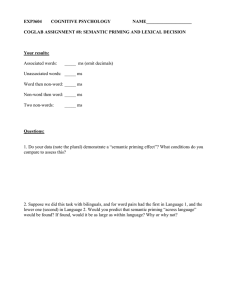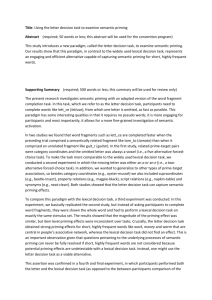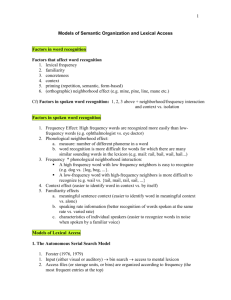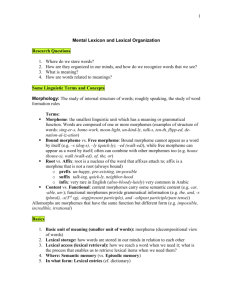Word recognition and sound merger: the case of the front-
advertisement
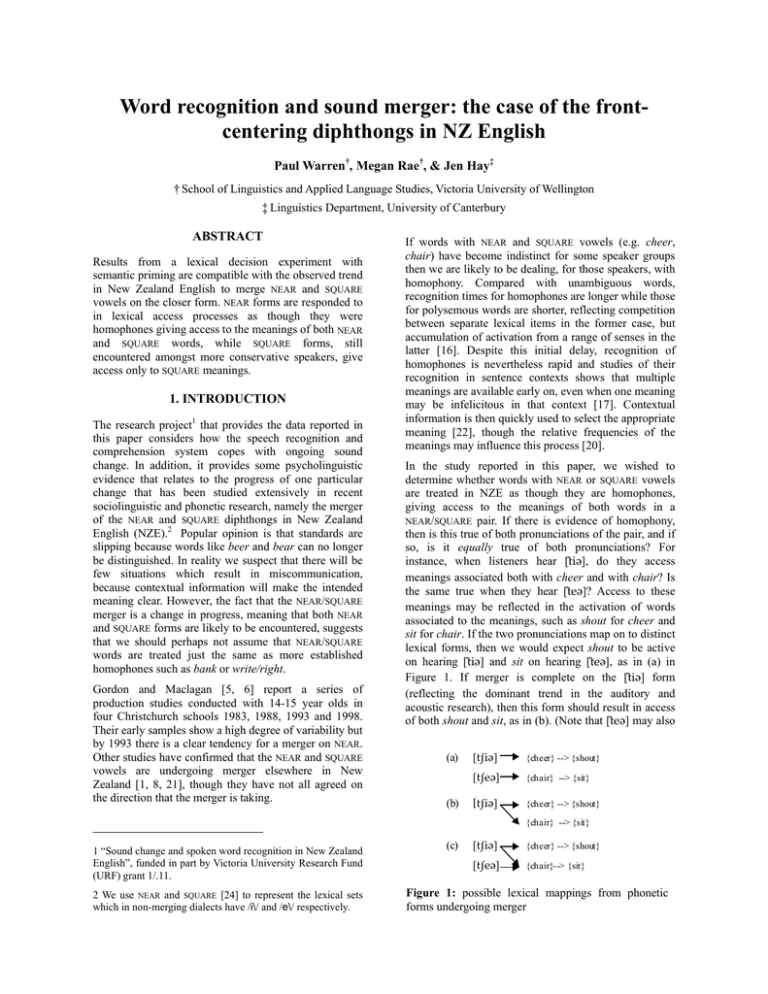
Word recognition and sound merger: the case of the frontcentering diphthongs in NZ English
Paul Warren†, Megan Rae†, & Jen Hay‡
† School of Linguistics and Applied Language Studies, Victoria University of Wellington
‡ Linguistics Department, University of Canterbury
ABSTRACT
Results from a lexical decision experiment with
semantic priming are compatible with the observed trend
in New Zealand English to merge NEAR and SQUARE
vowels on the closer form. NEAR forms are responded to
in lexical access processes as though they were
homophones giving access to the meanings of both NEAR
and SQUARE words, while SQUARE forms, still
encountered amongst more conservative speakers, give
access only to SQUARE meanings.
1. INTRODUCTION
The research project1 that provides the data reported in
this paper considers how the speech recognition and
comprehension system copes with ongoing sound
change. In addition, it provides some psycholinguistic
evidence that relates to the progress of one particular
change that has been studied extensively in recent
sociolinguistic and phonetic research, namely the merger
of the NEAR and SQUARE diphthongs in New Zealand
English (NZE).2 Popular opinion is that standards are
slipping because words like beer and bear can no longer
be distinguished. In reality we suspect that there will be
few situations which result in miscommunication,
because contextual information will make the intended
meaning clear. However, the fact that the NEAR/SQUARE
merger is a change in progress, meaning that both NEAR
and SQUARE forms are likely to be encountered, suggests
that we should perhaps not assume that NEAR/SQUARE
words are treated just the same as more established
homophones such as bank or write/right.
Gordon and Maclagan [5, 6] report a series of
production studies conducted with 14-15 year olds in
four Christchurch schools 1983, 1988, 1993 and 1998.
Their early samples show a high degree of variability but
by 1993 there is a clear tendency for a merger on NEAR.
Other studies have confirmed that the NEAR and SQUARE
vowels are undergoing merger elsewhere in New
Zealand [1, 8, 21], though they have not all agreed on
the direction that the merger is taking.
If words with NEAR and SQUARE vowels (e.g. cheer,
chair) have become indistinct for some speaker groups
then we are likely to be dealing, for those speakers, with
homophony. Compared with unambiguous words,
recognition times for homophones are longer while those
for polysemous words are shorter, reflecting competition
between separate lexical items in the former case, but
accumulation of activation from a range of senses in the
latter [16]. Despite this initial delay, recognition of
homophones is nevertheless rapid and studies of their
recognition in sentence contexts shows that multiple
meanings are available early on, even when one meaning
may be infelicitous in that context [17]. Contextual
information is then quickly used to select the appropriate
meaning [22], though the relative frequencies of the
meanings may influence this process [20].
In the study reported in this paper, we wished to
determine whether words with NEAR or SQUARE vowels
are treated in NZE as though they are homophones,
giving access to the meanings of both words in a
NEAR/SQUARE pair. If there is evidence of homophony,
then is this true of both pronunciations of the pair, and if
so, is it equally true of both pronunciations? For
instance, when listeners hear [tfli\], do they access
meanings associated both with cheer and with chair? Is
the same true when they hear [tfle\]? Access to these
meanings may be reflected in the activation of words
associated to the meanings, such as shout for cheer and
sit for chair. If the two pronunciations map on to distinct
lexical forms, then we would expect shout to be active
on hearing [tfli\] and sit on hearing [tfle\], as in (a) in
Figure 1. If merger is complete on the [tfli\] form
(reflecting the dominant trend in the auditory and
acoustic research), then this form should result in access
of both shout and sit, as in (b). (Note that [tfle\] may also
(a)
(b)
[tßi\]
{cheer} --> {shout}
[tße\]
{chair} --> {sit}
[tßi\]
{cheer} --> {shout}
{chair} --> {sit}
1 “Sound change and spoken word recognition in New Zealand
English”, funded in part by Victoria University Research Fund
(URF) grant 1/.11.
2 We use NEAR and SQUARE [24] to represent the lexical sets
which in non-merging dialects have /i\/ and /e\/ respectively.
(c)
[tßi\]
{cheer} --> {shout}
[tße\]
{chair}--> {sit}
Figure 1: possible lexical mappings from phonetic
forms undergoing merger
give access to these, as a phonetic variant.) Given,
however, that the merger is currently in progress, we
actually predict that there will be an asymmetry in the
availability of the different meanings, such that [tfli\] will
give access to both meanings (as a homophone), but that
[tfle\], which is still heard in the environment (as the
form for chair amongst more conservative speakers),
will give access to the sit meaning, as in (c).
2. EXPERIMENT
To investigate these possibilities, we used a semantic
priming paradigm that explores access to the meanings
of ambiguous words in isolation from context. This
requires subjects to respond to pairs or series of items
which bear some meaning relationship to one another, as
well as to unrelated items. Semantic priming obtains
when a word is responded to more rapidly or more
accurately when it has been preceded by a related word
[12]. Since recent research has shown that semantic
priming is more robust for semantic associates than for
words related simply through common semantic features
[7, 14, 15], our experiment uses words related by
association, as determined from published association
norms [3, 4, 13]. Semantic priming tasks tend to use
either paired presentation (subjects hear or see items
presented as a pair) or list presentation (items are
presented as single items in a long list of items). Since
detailed studies of priming paradigms have argued that
list presentation is less likely than paired presentation to
result in strategic approaches such as post-lexical
relatedness checking [11, 18], we elected to use list
presentation in our experiment. In consequence this
entails an auditory-auditory rather than cross-modal
presentation of prime and probe items.
2.1 Materials and design
Test materials comprised 12 pairs of NEAR/SQUARE items
(e.g. [tfli\] and [tfle\]) serving as test primes, probes
semantically associated to each of these 24 items, and 24
control primes, which were words semantically
unrelated to the probes [9]. All items were monosyllabic
and approximately matched for frequency. For some test
pairs there are NEAR or SQUARE forms which are
themselves homophones (e.g., deer and dear; bear and
bare; sheer and shear). As the stimuli are presented
auditorily, choosing between the meanings of these
homophonous pair members does not affect the form of
the prime, but it does affect the selection of the probe
word. Given that we needed, in the list presentation
format, to allow sufficient time after each item for a
lexical decision to be made, our preference was to use
associates of the dominant meaning of the form
(frequencies taken from [23]), since the dominant
meaning has been shown to persevere over time [7, 19].
However, in some cases the most frequent meaning has
less clear associates than another meaning. For example,
the frequency corpora gave sheer a higher frequency
than shear, but intuitively, shear followed by sheep
would provide greater priming effects than sheer
followed by cliff or tights. In such cases, a lower
frequency prime meaning was chosen, to ensure that
there was a clear associate, though it is worth stressing
that the frequency difference between homophonous
members such as sheer and shear was never great.
Probe words were selected on the basis of three sets of
published association norms [3, 4, 13], using where
possible concrete and natural category words [15]. In
some instances these constraints meant that the probes
were not the most frequent response in the association
data. For prime words not found in the association
norms, probe words were chosen based on intuition.
Control and filler words were selected from a
computerised list of monosyllables. Control words were
unrelated to probes and were open syllables,
phonologically matched with the NEAR/SQUARE prime
words. Twenty real-word fillers helped disguise the test
materials in order to reduce the risk of strategies such as
relatedness checking. Finally, 44 non-words were
included, which were constructed by altering one
phoneme in existing words – e.g., jatt from cat.
All stimuli were recorded onto digital tape by a native
NZ English speaker who was asked to be careful to
distinguish the NEAR and SQUARE vowels. Her own
spontaneous speech does distinguish the two, but not
consistently for all words. Stimuli were then transferred
to Macintosh computer for use in the experiment.
The overall design consisted of 4 test conditions (NEAR
and SQUARE primes followed by probes related to each)
and 2 control conditions (unrelated primes before each
of these probes). The four test conditions were rotated
across the 24 items to produce four test blocks, each of
which contained six items in each condition, along with
filler and nonword items. A fifth block included the
control condition. The experiment was run in a repeated
measures design because our research goals included a
comparison of priming effects for each subject with their
own realisation of the NEAR/SQUARE difference. Each
subject completed two sessions (a week apart) with two
of the test blocks in each session. Session one included
block 1 and block 2 and session two included block 3
and block 4, but the order of blocks within sessions
varied across subjects. For any item the two blocks in a
session did not include a repetition of either the prime or
the probe word for that item. Filler tasks were completed
between the test blocks, in order to reduce long-term
priming of probes by related items occurring in the
preceding block. However, because of fatigue effects
that showed up in the data, we present results here only
for responses from the first block in each session.
The 16 subjects were Linguistics undergraduates at
Victoria University who volunteered as a part of their
course of study, but who were naïve concerning the
purpose of the experiment. They were all fluent native
NZE speakers, aged 18-25 with no known hearing
impairment. They were tested individually in a quiet
room. They heard the sequence of real word and non
word stimuli over closed-ear headphones and pressed
one of two response buttons on a millisecond timer to
indicate a real word or non word decision. The
experiment was controlled by the PsyScope programme
[2]. The inter-stimulus interval was set at 1400
milliseconds - long enough to allow subjects to respond,
but short enough to maintain a fast response rate.
appropriate
inappropriate
40
20
2.2 Results
Response times (RTs) for each item were recorded in
milliseconds. One item set – fear/fair – was excluded
because of experimenter error. Missing and incorrect
responses were also excluded, affecting 3.69% of the
test and control data. Facilitation times (FTs) were
calculated by subtracting a subject’s RT for a probe in a
test condition from that subject’s RT to the same probe
in the control condition. Average FTs in each of the four
test conditions were calculated for each subject, and the
resulting averages were subjected to Analysis of
Variance (ANOVA), with Facilitation Time as the
dependent variable and Prime (NEAR word vs SQUARE
word) and Probe (appropriate [e.g. word related to the
NEAR word occurring after the NEAR word] or
inappropriate [e.g. word related to the SQUARE word
occurring after the NEAR word]) as independent
variables.3 In addition, planned comparisons of probe
types following each kind of prime were used to test the
predictions entailed in Figure 1. Overall averages for
the four conditions are shown in Figure 2.
The statistical analysis confirmed that appropriate
probes received more priming than inappropriate probes
(F(1,15)=5.85, p <0.03). In addition, there was a
significant interaction of prime and probe type
(F(1,15)=4.90, p<0.05). In the planned comparisons,
SQUARE primes facilitated appropriate probes more than
inappropriate probes ([tfle\]-sit > [tfle\]-shout;
F(1,30)=6.10, p<0.02), but there was no difference in
priming of the two probe types by NEAR primes ([tfli\]shout ≈ [tfli\]-sit) (F(1,30)=0.23, p>0.60).
3. DISCUSSION
The result for NEAR forms supports our prediction that
they are ambiguous between NEAR and SQUARE words,
following the trend in NZE towards merger on NEAR.
Thus, forms containing the [i\] vowel are treated as
though they are homophones, resulting in semantic
priming of both NEAR-related and SQUARE-related
associates. The fact that there is facilitation of SQUARErelated probes after SQUARE forms shows that these
forms are still recognised. However, the lack of
facilitation of NEAR-related words after the [e\] vowel
suggests that the SQUARE form is not homophonous
between SQUARE and NEAR - the SQUARE form is not a
3
facilitation
(msec) 60
An ANOVA was not performed on item means, since the item
selection almost exhausted the set of relevant words in the
language, so that the items were not selected randomly [10].
0
-20
NEAR
SQUARE
prime type
Figure 2. Average facilitation times for appropriate
and inappropriate probes after NEAR and SQUARE
primes (eg., from left to right, cheer-shout; cheersit; chair-sit; chair-shout).
phonetic variant of the NEAR form, but is continues to be
recognised as a separate form.
A further observation from the our results provides some
support for the contention that NEAR forms are
homophonous but SQUARE forms are not. Recall that
recent work has shown that homophones are responded
to more slowly than unambiguous words [16], reflecting
competition between two different words with the same
form. Analysis of lexical decision responses to the NEAR
and SQUARE words in our experiment confirms that the
former are responded to more slowly (894 vs 868 msec,
t=2.94, df:15, p<0.02). In addition the data in Figure 2
appear to show a knock-on effect for the associates
presented subsequently, with lower levels of facilitation
for either probe word following NEAR primes than for
the SQUARE probe word following the SQUARE prime.
Overall the result of this experiment provides support
from a spoken word recognition study for the view that
the merger of NEAR and SQUARE vowels is towards the
closer NEAR form. The asymmetry in the data would be
difficult to explain if the merger was in the opposition
direction, towards SQUARE, since this would predict that
the SQUARE form would prime associates of the NEAR
word, which is the condition in our experiment that
shows no facilitation. It would seem that the presence of
the SQUARE form (mainly in the speech of more
conservative NZE speakers) is sufficiently strong to
result in recognition of this form and significant
facilitation of associates of the SQUARE words.
Future research will examine effects of sentence context
on the recognition of our NEAR/SQUARE tokens. For
instance, will there be immediate access to multiple
meanings and rapid integration of contextual
information in the process of selecting from those
meanings for NEAR words [22]? What will we find for
SQUARE words – will there be early access to multiple
meanings that is not evidenced in the auditory-auditory
priming task with its longer inter-stimulus interval?
Finally, we wish in our future research to examine the
effects on perception and recognition of demographic
information concerning the speaker. If the distinction
between NEAR and SQUARE forms is indicative of a more
conservative speaker, will participants who believe the
speech to have come from an older speaker respond
differently from those who believe the same tokens to
have come from a young speaker?
REFERENCES
[1]
M. Batterham, "The apparent merger of the front
centring diphthongs - EAR and AIR - in New Zeland
English", In A. Bell, K. Kuiper, (eds.), New Zealand
English, Amsterdam: John Benjamins, 2000. pp. 111145.
[2]
J.D. Cohen, B. MacWhinney, M. Flatt, and J. Provost,
"Psyscope: A new graphic interactive environment for
designing psychology experiments." Behavioural
Research Methods, Instruments & Computers, 25(2), pp.
257-271, 1993.
[3]
Edinburgh Associative Thesaurus. Accessed: October
2002. http://monkey.cis.rl.ac.uk/Eat/htdocs/eat_old.html.
[4]
Florida Free Association Norms. Accessed: October
2002. http://w3.usf.edu/freeassociation.
[5]
E. Gordon and M. Maclagan. "Are we NEAR the
SQUARE?" A real time study of the merger of two
centering diphthongs in New Zealand English.
Linguistic Society of New Zealand. Palmerston North.
1999.
[6]
[7]
[8]
[9]
E. Gordon and M. Maclagan, ""Capturing a sound
change": A real time study over 15 years of the
NEAR/SQUARE diphthong merger in New Zealand
English." Australian Journal of Linguistics, 21(2), pp.
215-238, 2001.
Y. Hino, S.J. Lupker, and C.R. Sears, "The effects of
word association and meaning frequency in a crossmodal lexical decision task: Is the priming due to
"semantic" activation?" Canadian Journal of
Experimental Psychology, 51(3), pp. 195-210, 1997.
J. Holmes and A. Bell, "On shear markets and sharing
sheep: The merger of EAR and AIr diphthongs in New
Zealand English". Language Variation and Change, 4,
pp. 251-273, 1992.
J. Jonides and R. Mack, "On the cost and benefit of cost
and benefit". Psychological Bulletin, 96(1), pp. 29-44,
1984.
[10] G. Keppel, "Words as random variables". Journal of
Verbal Learning and Verbal Behaviour, 15, pp. 263-265,
1976.
[11] T.P. McNamara and J. Altarriba, "Depth of spreading
activation revisited: semantic mediated priming occurs
in lexical decisions". Journal of Memory and Language,
27, pp. 545-559, 1988.
[12] D.E. Meyer and R.W. Schvaneveldt, "Facilitation in
recognizing pairs of words: Evidence of a dependence
between retrieval operations". Journal of Experimental
Psychology, 21, pp. 863-883, 1971.
[13] H.E. Moss and L. Older, Birkbeck Word Association
Norms, Hove, UK: Lawrence Erlbaum, 1996.
[14] H.E. Moss, R.K. Ostrin, L.K. Tyler, and W.D. MarslenWilson. Semantic and associative priming within and
across modalities. 25th International Congress of
Psychology. Brussels, Belgium. 1992.
[15] H.E. Moss, R.K. Ostrin, L.K. Tyler, and W.D. MarslenWilson, "Accessing different types of lexical semantic
information: evidence from priming". Journal of
Experimental Psychology: Learning, Memory, and
Cognition, 21(4), pp. 863-883, 1995.
[16] J. Rodd, M.G. Gaskell, and W.D. Marslen-Wilson,
"Making sense of semantic ambiguity: semantic
competition in lexical access". Journal of Memory and
Language, 46, pp. 245-266, 2002.
[17] M.S. Seidenberg, M.K. Tanenhaus, J.M. Leiman, and M.
Bienkowski, "Automatic access of the meanings of
ambiguous words in context: some limitations of
knowledge-based processing". Cognitive Psychology,
14, pp. 489-537, 1982.
[18] J.R. Shelton and R.C. Martin, "How semantic is
automatic semantic priming?" Journal of Experimental
Psychology: Learning, Memory, and Cognition, 18(6),
pp. 1191-1210, 1992.
[19] G.B. Simpson, "Meaning dominance and semantic
context in the processing of lexical ambiguity". Journal
of Verbal Learning and Verbal Behavior, 20, pp. 120136, 1981.
[20] G.B. Simpson, "Context and the processing of
ambiguous words", In M.A. Gernsbacher, (ed.),
Handbook of psycholinguistic research, San Diego:
Academic Press, 1994. pp. 359-374.
[21] D. Starks, S. Allan, and C. Kitto. Why vernacular
speech? Speech samples from the taped Auckland rapid
and anonymous survey. New Zealand Language and
Society Conference. Victoria University of Wellington.
1998.
[22] D.A. Swinney, "Lexical access during sentence
comprehension: (Re) consideration of context effects".
Journal of Verbal Learning and Verbal Behaviour, 18,
pp. 645-659, 1979.
[23] Wellington Corpora of New Zealand English. Accessed:
February 2003. http://www2.vuw.ac.nz/lals/corpora.htm.
[24] J.C. Wells, Accents of English, Cambridge: Cambridge
University Press, 1982.
